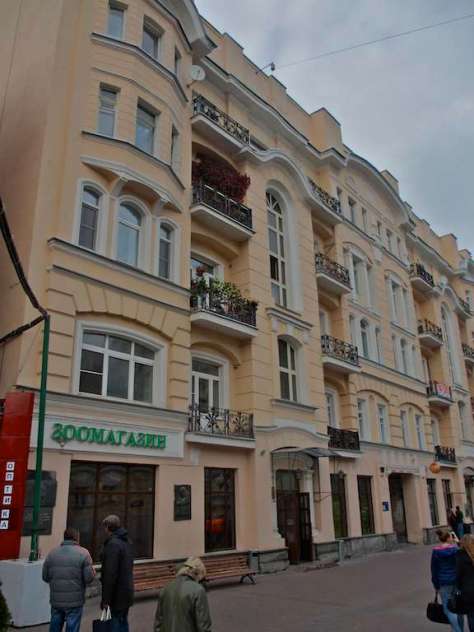If you read this blog you have seen this building already. It came up awhile back when I wrote about the exquisite Soviet prose writer Yury Kazakov, who lived here. But this building at 30/3 Arbat was also home much earlier to the painter Sergei Vasilyevich Ivanov. I provide Ivanov’s patronymic because there are numerous artists named Ivanov and even two or three others with the first name of Sergei. We’re talking about the Sergei Ivanov who was born in 1864 and died in 1910. He was a member of the influential and ever-popular group of artists called the Peredvizhniki, or the Wanderers or Itinerants, along with Ilya Repin, Ivan Shishkin, Vasily Surikov, Arkhip Kuindzhi, Ivan Kramskoi, Valentin Serov, Isaak Levitan, Viktor Vasnetsov and other great landscape and narrative painters. He was always something of an upstart politically and socially, and it’s perhaps not surprising that he ended up quitting the prestigious Academy of Arts in Petersburg before finishing his education because, in part, he didn’t like the way the place was run. Ivanov was one of the founders of the Union of Russian Artists.
Different sources provide different titles for Ivanov’s first painting, but it’s clear he made an impact from the very beginning of his artistic career. One source, Russian painting, declares that Ivanov’s first canvas was “On the Road. The Death of a Migrant” (1889) and that it brought the artist immediate fame. Indeed it is a powerful piece showing a family in the middle of nowhere left destitute by the unexpected death of the head of the household. Russian Wikipedia goes back to 1883 and the painting “The Blind Ones” for the beginning. This is probably closer to the truth, referring to an early student work, while the reference to “On the Road” is probably to Ivanov’s first “professional” work. I’ll leave the bean-sorting to the experts and just point out this – both of these paintings are clearly intended to make moral and social statements. The shorthand here is that Ivanov was not one to turn a blind eye to injustice and the difficulties of the world in order to live out his life in art comfortably. Not surprisingly, I think, this remained a part of the artist’s personal makeup throughout his entire life. He was a witness to, and a participant in, a massacre of Moscow students by the police during the failed revolution of 1905. According to the Famous Russian Artists site, he attended to wounded students in the building of Moscow University. (See below for more on this.) This led to him painting one of his most famous late works, “The Execution,” a grimly laconic piece showing two bodies lying in the snow against an urban background. Ivanov never showed this painting to anyone during his lifetime and it was first publicly exhibited only in 1917.
Uncharacteristically, the plaque honoring Ivanov says nothing about when he lived at this address. A bit of research gives us answers, however. The rather pink building you see here was erected as an apartment house in 1904 and we have references to people visiting Ivanov here as early as 1905. A site called Akademik lists all of Ivanov’s addresses in Moscow – Khilkov Lane, Plyushchikha, Ostozhenka and Arbat. Considering that Arbat is the last of the addresses named, and considering that the building Ivanov lived in went up only in 1904 and that he died in 1910, I think we’re relatively safe to say he was resident here from 1904 to 1910. (Also living here at the same time was the prominent sculptor Sergei Konenkov – I’ll have to do something on him another time.) One of the sources putting Ivanov in this building in 1905 is Moscow University Professor Vladimir Kostitsyn, a participant in revolutionary activities in the early 20th century, who recalled leaving the scene of battles and “setting out for the Arbat, where I hoped that the artist S.V. Ivanov, who often did us big favors, would help me find Pavel Ivanovich Pervukhin, a member of the Mobilization Committee…”
I draw this last quote from Lev Kolodny’s book The Backstreets of the Arbat, which is available to be read for free on the internet. Here is part of a paragraph on Ivanov taken from this book:
“The students delegated the safety of the buildings at Moscow University to the artist [Ivanov] on the day of Nikolai Bauman’s funeral [i.e., late October- JF]. Ivanov was an eye-witness to the execution of young people returning from a political demonstration. As bullets whizzed around him, he transported the wounded to the university’s auditorium. We, his heirs, can see what that must have looked like in Ivanov’s paintings devoted to the First Russian Revolution. One is called ‘Auditorium of Moscow University, Transformed into a Hospital on the Night of October 20-21, another… is ‘The Execution.’



